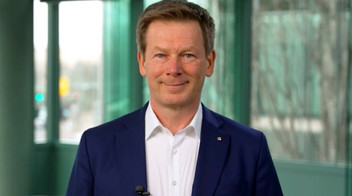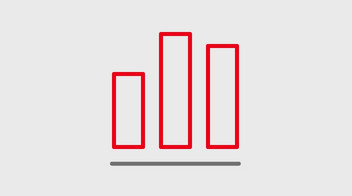Energy efficiency
Increasing energy efficiency is another component of achieving our climate protection target. Our measures to increase energy efficiency include, in particular, further electrifying our track infrastructure and reducing our energy consumption.
Share of electrification in Germany / % | 2023 | 2022 | 2021 |
Electrification of track infrastructure (length of line operated) | 62.3 | 61.7 | 61.5 |
Electrification of high-performance network 1) | 99.0 | – | – |
Transports carried out electrically by DB Group in rail passenger transport and rail freight transport (based on weight-related ton-kilometers; Ltkm) 2) | 93.0 | 92.7 | 92.3 |
1) The electrification of the Fehmarn Belt fixed link, which has not yet been completed, corresponds to about 1% of the high-performance network.
2) Includes DB Fernverkehr AG, DB Regio AG, S-Bahn Hamburg GmbH, S-Bahn Berlin GmbH, RegioNetz Verkehrs GmbH, DB Cargo AG, without switching maneuvers.
- In 2023, we started preliminary planning for the electrification of 55 km along the Landshut — Mühldorf line, meaning that in future, climate-friendly journeys from the Inn to the Isar will be possible.
- In addition, we are consistently renewing our fleet. For example, we rely on feeding converted braking energy into the overhead wire for our new locomotives and multiple units. In 2023, the energy recovery rate was 17.9%, as in the previous year. In 2023, the fleet of vehicles equipped with energy recovery technology continued to grow, e.g. due to the addition of additional ICE 3neo and ICE 4 trains.
- We are also training and supporting our drivers in energy-saving driving. The continuous roll-out of driver assistance systems such as LEADER at DB Cargo and RESY at DB Regional, or the use of longer trains at DB Cargo, are helping us to further reduce consumption and increase energy efficiency.
- In 2023, we carried out an analysis of energy consumption at a DB Regional maintenance depot in Aachen, where self-closing hall doors were installed. We achieved savings of about 13% in energy consumption, meaning that we started planning for refitting at three other sites in 2023.
- We commissioned TU Darmstadt with a study for a pilot project to examine the technical feasibility and potential estimation of geothermal energy in tunnel construction to increase our energy efficiency.
Specific primary energy consumption by DB Group journeys and transport | 2023 | 2022 | Change | 2021 | |
absolute | % | ||||
Regional rail passenger transport (MJ/pkm) | 0.73 | 0.83 | –0.10 | –12.0 | 1.37 |
in Germany | 0.68 | 0.82 | –0.14 | –17.1 | 1.34 |
Long-distance rail passenger transport (MJ/pkm) | 0.21 | 0.23 | –0.02 | –8.7 | 0.35 |
Bus transport (MJ/pkm) | 1.04 | 1.11 | –0.07 | –6.3 | 1.49 |
in Germany | 1.43 | 1.57 | –0.14 | –8.9 | 1.66 |
Rail freight transport 1) (MJ/tkm) | 0.31 | 0.28 | +0.03 | +10.7 | 0.30 |
in Germany | 0.27 | 0.26 | +0.01 | +3.8 | 0.28 |
Road freight transport 2) (MJ/tkm) | 1.29 | 1.22 | +0.07 | +5.7 | 1.23 |
Air freight 3) (MJ/tkm) | 9.37 | 9.17 | +0.20 | +2.2 | 9.29 |
Ocean freight 3) (MJ/tkm) | 0.08 | 0.08 | – | – | 0.07 |
Well-to-wheel (WTW); Scope 1 –3; rail transport companies are taken into account with their own electricity mix or their respective national mixes. Includes DB Arriva.
1) In 2021, rail freight transport from/to China by DB Cargo and DB Schenker may have included double accounting, and so these values may be slightly higher.
2) Excluding USA Truck.
3) Excluding pre-carriage and on-carriage.
The improvement in the specific primary energy consumption in regional and long-distance rail passenger transport is due to a further increase in train utilization and efficiency measures to reduce energy consumption. The deterioration in rail freight transport resulted from a noticeable decline in performance. The freight forwarding and logistics sector also recorded a decline in volumes in 2023. In addition, deterioration in capacity utilization in road freight traffic and the increased use of older freight aircraft and more belly freight (i.e. passenger aircraft transporting freight under the lower deck) also had a negative impact.
Stationary energy consumption
Absolute primary energy consumption of DB Group stationary facilities in Germany / terajoules (TJ) | 2023 | 2022 | Change | 2021 | |
absolute | % | ||||
Rail network operation | 4,966 | 5,128 | –162 | –3.2 | 5,600 |
Passenger stations | 2,333 | 2,519 | –186 | –7.4 | 2,640 |
Maintenance of rolling stock (facilities) | 2,721 | 2,978 | –257 | –8.6 | 2,539 |
Other | 3,227 | 3,182 | +45 | +1.4 | 4,157 |
Total | 13,248 | 13,807 | –559 | –4.0 | 14,936 |
Individual figures are rounded and therefore may not add up.
By disclosing primary energy consumption, we also take into account the upstream processes involved in providing energy, such as the extraction, treatment and transport of fuels or processes for generating electricity. Our about 5,400 stations, interlockings and operating facilities, our depots and buildings in Germany, DB Schenker’s more than 1,850 sites worldwide and the DB Arriva and DB Cargo sites in other European countries account for 6.7% of DB Group’s total primary energy consumption (previous year: 6.1%).
In order to continuously identify savings potential and sustainably reduce energy consumption and therefore greenhouse gas emissions, nine Group companies, including DB Energie GmbH, DB Regio AG and DB Fernverkehr AG, are currently operating a certified energy management system (EnMS) in accordance with DIN EN ISO 50001. According to estimates, 40 Group companies will be affected by the obligation to introduce an EnMS in accordance with the Energy Efficiency Act (EnEfG) which entered into force in 2023.


